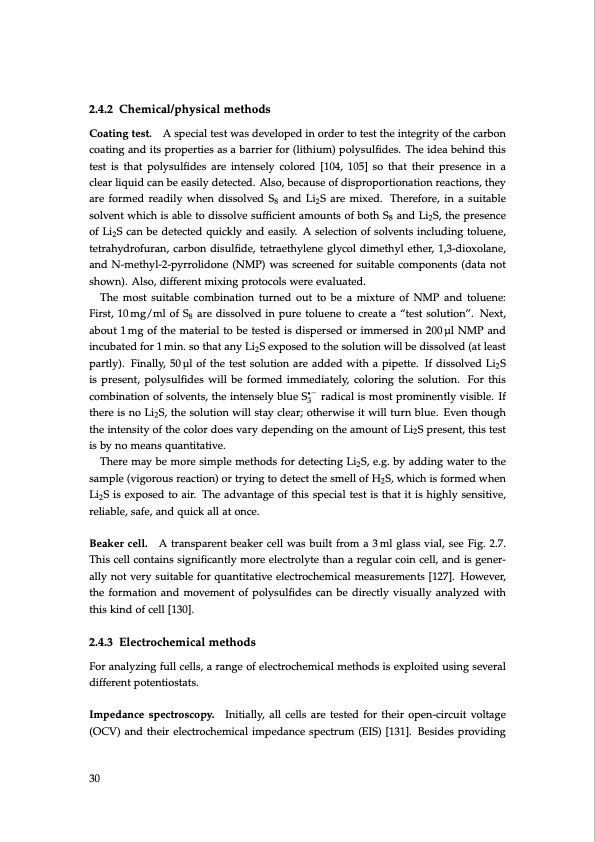
PDF Publication Title:
Text from PDF Page: 030
2.4.2 Chemical/physical methods Coating test. A special test was developed in order to test the integrity of the carbon coating and its properties as a barrier for (lithium) polysulfides. The idea behind this test is that polysulfides are intensely colored [104, 105] so that their presence in a clear liquid can be easily detected. Also, because of disproportionation reactions, they are formed readily when dissolved S8 and Li2S are mixed. Therefore, in a suitable solvent which is able to dissolve sufficient amounts of both S8 and Li2S, the presence of Li2S can be detected quickly and easily. A selection of solvents including toluene, tetrahydrofuran, carbon disulfide, tetraethylene glycol dimethyl ether, 1,3-dioxolane, and N-methyl-2-pyrrolidone (NMP) was screened for suitable components (data not shown). Also, different mixing protocols were evaluated. The most suitable combination turned out to be a mixture of NMP and toluene: First, 10 mg/ml of S8 are dissolved in pure toluene to create a “test solution”. Next, about 1 mg of the material to be tested is dispersed or immersed in 200 μl NMP and incubated for 1 min. so that any Li2S exposed to the solution will be dissolved (at least partly). Finally, 50μl of the test solution are added with a pipette. If dissolved Li2S is present, polysulfides will be formed immediately, coloring the solution. For this combination of solvents, the intensely blue S•− radical is most prominently visible. If 3 there is no Li2S, the solution will stay clear; otherwise it will turn blue. Even though the intensity of the color does vary depending on the amount of Li2S present, this test is by no means quantitative. There may be more simple methods for detecting Li2S, e.g. by adding water to the sample (vigorous reaction) or trying to detect the smell of H2S, which is formed when Li2S is exposed to air. The advantage of this special test is that it is highly sensitive, reliable, safe, and quick all at once. Beaker cell. A transparent beaker cell was built from a 3 ml glass vial, see Fig. 2.7. This cell contains significantly more electrolyte than a regular coin cell, and is gener- ally not very suitable for quantitative electrochemical measurements [127]. However, the formation and movement of polysulfides can be directly visually analyzed with this kind of cell [130]. 2.4.3 Electrochemical methods For analyzing full cells, a range of electrochemical methods is exploited using several different potentiostats. Impedance spectroscopy. Initially, all cells are tested for their open-circuit voltage (OCV) and their electrochemical impedance spectrum (EIS) [131]. Besides providing 30PDF Image | Lithium-Sulfur Battery: Design, Characterization, and Physically-based Modeling

PDF Search Title:
Lithium-Sulfur Battery: Design, Characterization, and Physically-based ModelingOriginal File Name Searched:
Dissertation_David_N._Fronczek_The_Lithium_Sulfur_Battery.pdfDIY PDF Search: Google It | Yahoo | Bing
Sulfur Deposition on Carbon Nanofibers using Supercritical CO2 Sulfur Deposition on Carbon Nanofibers using Supercritical CO2. Gamma sulfur also known as mother of pearl sulfur and nacreous sulfur... More Info
CO2 Organic Rankine Cycle Experimenter Platform The supercritical CO2 phase change system is both a heat pump and organic rankine cycle which can be used for those purposes and as a supercritical extractor for advanced subcritical and supercritical extraction technology. Uses include producing nanoparticles, precious metal CO2 extraction, lithium battery recycling, and other applications... More Info
| CONTACT TEL: 608-238-6001 Email: greg@infinityturbine.com | RSS | AMP |